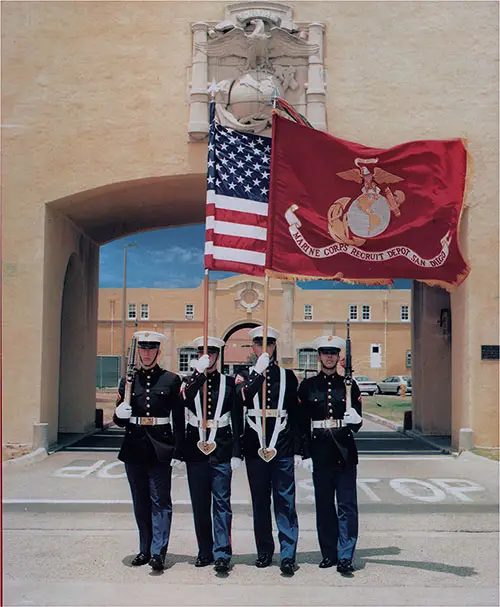Marine Corps Recruit Depot - San Diego, California

Four Marines in Parade Dress Carrying the US Flag and Flag of the USMC, Standing Outside San Diego MCRD. GGA Image ID # 137460b273
The Marine Corps Recruit Depot has, over the years, been the home of the famed 4th and 6th Marine Regiments, the site of many specialized schools and a recruit training center.
During World War II it served as a Training Center, Supply Depot and Embarkation Point for thousands of Marines who defeated the Japanese in the Pacific. Approximately 222,300 recruits earned the title Marine at the Depot during those years.
The Depot’s post-war mission encompasses both recruiting and recruit training for the Western portion of the United States. The Recruit Training Regiment has direct responsibility for the training of Marine recruits — young men who have volunteered for duty with the Corps.
During the twelve week schedule of recruit training, the new recruits undergo strenuous physical and mental challenges designed to instill in them the Core Values of the Marine Corps — honor, courage and commitment.
THE ESTABLISHMENT OF THE MARINE CORPS Base at San Diego was initiated by the late Major General Joseph H. Pendleton, USMC, in July 1914. He recognized in the harbor and environs of San Diego a strategic point where Marines could be trained for expeditionary duty, and where they could be ready to go aboard ship with all of their stores and equipment to areas in the Pacific where their services might be needed.
The first Marines moved into the partially completed barracks from a camp in Balboa Park in December 1921. The practical construction was completed in 1924. Much of the land was reclaimed from San Diego Bay, including that portion comprising Lindbergh Field and the adjacent shore area.
To the recruit facing his initial weeks of training, his Drill Instructor is the most important person. Chosen for exceptional leadership ability and military experience, the Drill Instructor serves as a role model and teacher throughout the boot camp experience, guiding the recruits through the transformation process from civilian into Marine.
The training cycle is a progressive course, consisting of increasing levels of mental and physical challenges. In the eighth week, all of the training is put to the test during the Crucible. This 54-hour exercise tests each recruit’s skills, knowledge, and fitness, and also reinforces the importance of Core Values and teamwork.
Functioning on as few as four hours of sleep per night and one meal per day, the recruits complete a series of grueling events, culminating with a 10-mile hike that takes them up a hill known as “The Grim Reaper.”
There, the recruits participate in a morning colors ceremony, view a video message from the Commandant of the Marine Corps, and eat a well-deserved Warriors Breakfast.
After returning to the Depot, the recruits spend their final four weeks in swim training, demanding physical training, drill competitions, and uniform inspections. During the Emblem ceremony, each recruit earns the distinctive Marine emblem, and more importantly the title of “Marine.”
Finally, graduation day arrives. The new Marines march in a parade before proud parents, siblings, spouses, and friends. The Honormen return the platoon guidons to their Drill Instructors and the new Marines receive their final dismissal from their Senior Drill Instructors.
Immediately following completion of recruit training at the Depot, the majority of the young Marines are allowed to go on leave before reporting to the School of Infantry at Camp Pendleton, CA, for further indoctrination in basic infantry skills.
From there, the new Marines continue on to train in their military occupation specialties and then assume their duties at positions throughout the Marine Corps.
The Depot also offers facilities for continued education through the Marine Corps Institute, United States Armed Forces Institute several university and college extensions.
Every year, nearly 40,000 young men and women enter the Marine Corps. They receive their training at one of two places. Males from homes east of the Mississippi and all female recruits, go to the Marine Corps Recruit Depot at Parris Island, South Carolina. Male recruits from the Western portion of the United States come to Marine Corps Recruit Depot, San Diego.
The modem Marine Corps is a team which operates on land, at sea and in the air. It utilizes the latest developments in training and equipment. But it retains the “esprit de corps” that was traditional over a century before General Pendleton envisioned San Diego as a home for the Marine Corps.
